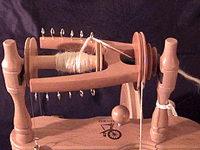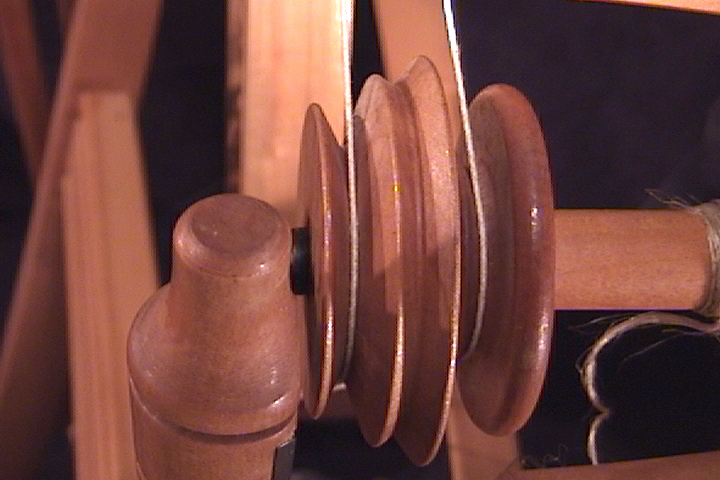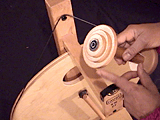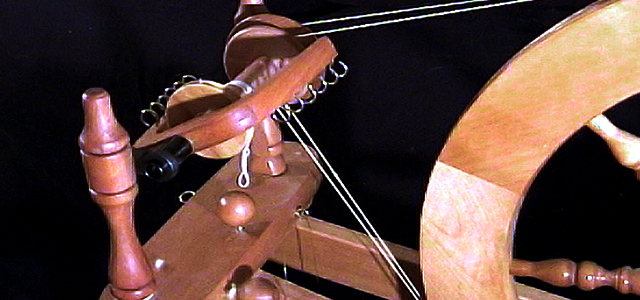The spindle and the drive wheel are rotated by a drive band. The spindle whorl is either on the flyer or attached to the spindle. It has 2-3 different pulley sizes which controls the speed of the flyer. The flyer has a row of hooks on one or both sides of the U-shaped arms to guide the yarn onto the bobbin evenly. On double drive wheels, the bobbin is rotated by its own pulley. On single drive wheels the bobbin has a separate brake to control its speed. The fiber is twisted as the flyer rotates and the spinner holds the yarn. One revolution of the flyer puts one twist into the yarn. The longer the yarn is held before letting it wind onto the bobbin, the more twist it will receive.
 Single Drive Wheels
Single Drive Wheels
This type of wheel has one drive band around the flyer wheel and the flyer whorl. There is usually a separate brake on the bobbin using an adjustable brake band or a tension wire (The Scotch Tension brake system), for the purpose of regulating the speed by which the yarn winds onto the bobbin.When spinning, a brake is used to hold the bobbin still while the flyer continues to rotate. Increased tension on the brake will cause the yarn to pull from your hands and to wind quickly onto the bobbin. Single drive wheels are the best choice for beginning handspinners. The Scotch Tension brake system is easier for beginners to operate and understand. The tension on the flyer and bobbin can be set at separate speeds, which provides numerous adjustment levels for the beginner. You will be able to spin a variety of yarn types; soft, lumpy, novelty, etc.
 Double Drive Wheels
Double Drive Wheels
This type of wheel has the flyer whorl and bobbin next to one another on the same side of the spindle. The drive band is doubled and forms a figure eight that loops onto both the bobbin and the flyer whorl. The spinner decides where the drive band is placed on the whorl depending upon the type of yarn to be spun. When spinning, both the flyer and the bobbin are rotated by the drive band. The bobbin whorl is smaller in diameter than the flyer whorl, therefore, it will spin faster than the flyer if there is no brake being used. Because of the high degree of twisting efficiency, beginners who have a problem with overtwisting the yarn, will find the double drive wheel difficult to use at first.
 Bobbin Lead Wheels
Bobbin Lead Wheels
The Louet spinning wheel is a good example of a bobbin lead wheel. The whorls are located on the bobbin instead of the flyer. The drive band goes around the drive wheel and one of the bobbin whorls. There is a single leather brake band that lays across the end of the flyer. It has an adjustable sleeve that can be tighten or loosened, to control the speed of the flyer. Bobbin lead wheels are a good choice for a beginner spinner. The tension is easier to control, and there is more traction created by the force of the drive wheel, which allows heavier, bulky yarns to wind onto the bobbin.


